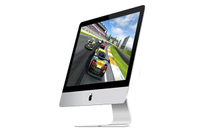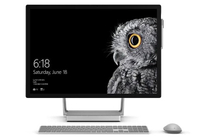All-in-One PC Buying Guide: 10 Tips for Finding the Right System
All-in-One PCs combine power and style into a single convenient design. Here's our buying guide to help you find the right desktop PC for you.

Choosing the Right All-in-One PC
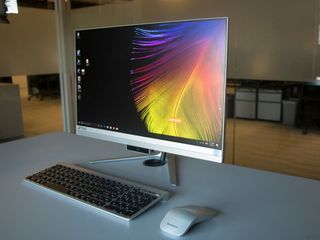
Looking to buy an all-in-one desktop? With all of the considerations of a regular PC plus the unique aspects of the integrated monitor and other features of an all-in-one design, there’s a lot to keep in mind when hunting for the best all-in-one PC. Use our advice to make sure you get the one that's right for you, whether you need powerful components or a big, beautiful display.
Quick Tips
- Hardware: Look for a system that has an Intel Core i5 or Core i7 CPU and at least 8GB of RAM.
- Storage: A dual-drive combination of 256GB solid-state drive and 1TB hard drive delivers performance without sacrificing capacity or costing an arm and a leg.
- Display: If you can get 4K resolution, go for it, but 27- and 28-inch displays offer the best balance of panel size and affordable price.
- Touch Screen: You’ll pay more for a touch-enabled display, so only get it if touch is on your must-have list.
- Design: If ergonomics are a concern, pay attention to what sort of stand a model has, since most of them don’t offer any sort of height adjustment.
- Operating System: Windows or Mac are both good choices, but stick to Windows if you want touch.
- Ports: You don’t just want lots of ports, you want them to be easy to reach, so pay attention to port placement.
- Sound: If audio quality is important, look for speakers - and lots of them.
- Price: All-in-One PCs run more expensive than regular desktops, but you can still get premium features without breaking the bank. You just need to be clear about what features are most important to you.
MORE: The Best All-in-One PCs - Computers for Families, Gaming & Design
Components: Which Specs Matter?
An all-in-one PC is, first and foremost, a computer, and the components inside determine what sort of performance the system will give you.
Marketing materials may lavish praise on any number of features, but there are four main specifications to pay attention to when buying any computer -- all-in-one or otherwise.
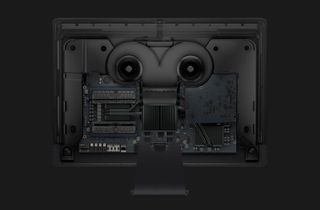
- Processor: While you can find all-in-one systems that use Intel Core i3 or Pentium CPUs, these are much less capable processors, and you’ll feel the limits of that performance much sooner. For most people, we recommend a current Intel Core i5 processor, which will offer plenty of performance for all your everyday uses and will continue to offer good support over the life of the computer. If you want more horsepower, stepping up to a Core i7 will offer plenty of power.
- RAM: Also called memory, RAM serves as the computer’s short-term storage for applications that are currently in use. A smaller allotment of RAM will limit your ability to multitask, even with a powerful processor. We recommend getting as much RAM as you can, but 8GB of RAM is enough to support most users in all of their computing needs. The good news is that RAM is relatively inexpensive, and it’s often one of the only parts of an all-in-one that can be upgraded by the user.
- Graphics: All the pretty visuals you see in games and videos require graphics processing. Most users can get by with integrated graphics, the graphics processing hardware that comes with your computer’s processor. It’s sufficient for the web browsing, office work and media streaming that make up the bulk of general computer use. However, if you want to play games or do more demanding, graphics-intensive work, you’ll want a system with a discrete graphics card.
- Storage: Finally, you’ll want something with a good size storage drive for all of your programs, files and family photos. The two big concerns with storage are capacity and speed. A 500GB hard drive will offer plenty of room for documents and photos, but a 1TB drive offers more room to accommodate video files and larger programs. A solid-state drive (SSD) will be faster than any hard drive, and you’ll feel the difference in your day to day use of the machine, but SSDs are more expensive for the same sort of capacity. Many PC manufacturers offer dual-drive configurations that give you the performance benefits of an SSD with the affordable capacity of a spindle-based hard drive. But if not, more storage is better.
It’s also worth remembering that, unlike a traditional desktop PC, there are very few upgrade options available for all-in-one systems after purchase. The compact design that fits all the computing hardware in with the display generally doesn’t allow user access to the internals, and no room to accommodate additional hardware. As a result, even simple upgrades like adding a discrete graphics card or switching out a storage drive aren’t viable options on an all-in-one. The one exception is that an all-in-one’s RAM often is accessible, and adding memory is a relatively inexpensive way to get a 2- or 3-year-old PC feeling new again.
Display: Size and Resolution
Most all-in-one systems have displays ranging in size from 20 inches on the small end to 32-inch displays on premium systems. We’d avoid anything smaller than 23 inches, unless you’re trying to fit the all-in-one into a cramped cubicle or tiny apartment. High-end 30- to 32-inch systems are nice if you can afford them, but are often cost-prohibitive. For our money, the sweet spot between spacious displays and reasonable pricing sits right at 27 or 28 inches.
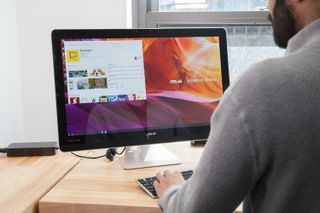
While most displays come in only two resolutions, full HD (1920 x 1080) or 4K (3840 x 2160), a few all-in-one systems offer displays that exceed 4K resolution. The Apple iMac 27-inch with 5k Retina display, for example, boasts a 5K (5120 x 2880) display, and the Microsoft Surface Studio has an impressive 28-inch, 4500 x 3000 display.
If you want to use the PC to view and edit 4K media, then a monitor with 4K (or better) resolution is a must-have. In general, 4K resolution is what we recommend; as 4K streaming through services like Netflix and YouTube becomes more common, you’ll definitely want a display that can handle the best picture available. However, if you’re looking for an opportunity to get an all-in-one PC for less, opting for a lower resolution display is one of the easiest ways to save money without sacrificing overall performance.
Touch Screen: Yes or No?
If you’ve grown accustomed to the tapping and swiping you do on your phone or tablet, and want that same intuitive interaction with your PC, an all-in-one with touch support is a great way to go. On the other hand, if you know you don’t want a touch screen or are unlikely to use it, then there’s no sense paying for a feature you won’t benefit from.

But there’s more to the equation than touch or no touch. Some touch-enabled PCs may rely on different touch-input technologies. While capacitive touch is most common, and the technology we recommend, you may still find AIO desktops on the market that use other methods of touch sensing, from infrared light or sound to resistive touch sensors. If you’re considering an option other than capacitive touch, take the time to find the system in a local store to try it yourself before purchase.
MORE: All-in-One PCs - Reviews, News and Our Top Picks
Finally, some all-in-one systems go beyond fingertip input and offer a stylus or pen. If you want to use your all-in-one for digital sketching and other media creation, then pen support might be a feature to look for.
Design: Form and Function
Unlike many other categories of PC, all-in-ones are defined by their form. The design of an all-in-one PC places all the components of a regular desktop computer into the same chassis as the monitor, hence the all-in-one name. This design reduces clutter on the desktop, since there’s only one power cable to connect, and no need to snake an extra cable around to connect a monitor. These systems usually come with wireless keyboards and mice, keeping the number of plugged in devices to a minimum. Whether you’re embracing the minimalist look or just trying to keep your desk organized, an all-in-one should help tame the tangle of cables that often accompanies a desktop PC.

That simplicity also means that all-in-one designs are nice for people who may be intimidated by a more complex desktop. Setup is usually as simple as plugging it in and pressing the power button, with very little assembly required, and no confusion about plugging the right cable into the right socket. This no-fuss approach makes the all-in-one a great choice as a family PC that may be used by parents and kids alike.
Since all-in-one PCs are both computer and monitor, there are ergonomic concerns to consider as well. All AIO desktops come with a built-in stand, but some are more adjustable than others. Some, like the Apple iMac 27-inch with 5k Retina display or the Asus Zen AiO Pro Z240IE, use a single pedestal-style stand. While these stands look very nice, they generally offer some angle adjustment, but no way to adjust the height of the system. Raising up the display requires stacking it on top of something, like a book, and lowering the display requires a lower table or desk entirely.
Other systems offer more flexible options, like the Microsoft Surface Studio and the Lenovo ThinkCentre M910z, which have two points of articulation for raising and lowering the display and adjusting the position to your exact needs.

There’s also the matter of style. While some all-in-ones are nearly as boxy and drab as a traditional PC tower, there are several that approach the humble personal computer as a designer object. While much of this focus on aesthetics can be traced back to Jonny Ive’s work on the Apple iMac, a similar eye for beauty has influenced the look of systems from most major manufacturers.
Operating System: Windows or MacOS?
The answer to which operating system is best for your all-in-one mostly comes down to which OS environment you’re already comfortable with. If you’re a Mac household and are used to MacBooks and iPads, it doesn’t make a lot of sense to get a Windows machine, and vice versa.

That said, there is one differentiating feature you may want to consider - touch. Where Windows has embraced touch support on laptops and desktops, Apple has kept touch support limited to iOS devices, with no touch option on MacOS. As a result, there is no touch-enabled iMac available. If touch is a must-have, you’ll want to look at Windows-based systems.
Ports
It’s not uncommon to see midrange AIOs skimp on the number and selection of ports, so look for a variety of ports, including USB-C, Thunderbolt, USB 3.0 and HDMI. One or two USB 2.0 ports are often meant for connecting keyboard and mouse, and memory card readers are useful but not ubiquitous.

Port placement is also important, with many all-in-one designs putting all the ports in difficult-to-reach spots, like behind the stand on the back of the display. Ports that are difficult to access are almost as bad as no ports, and you want to be able to reach ports to plug and unplug peripherals without having to reposition your entire system.
Finally, one useful feature found on many all-in-one PCs is an HDMI input, which lets you use the system as a standalone monitor. Whether you use it as a monitor for a gaming console or just as a monitor for a newer PC, this one feature can add years of use to an all-in-one that might be your main PC for only two or three years.
Sound
For making the most of your music and movies, you’ll want an all-in-one with a good set of speakers. The Dell XPS 27 has an integrated 10-speaker soundbar and some of the most impressive audio we’ve heard on a PC.
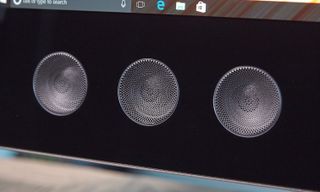
Many PC manufacturers will also partner with high-end audio companies like Bang & Olufsen or Dolby to offer higher quality sound. Other systems may have two, four or more speakers, and several have options for connecting external speakers for even better sound.
Price
So how much can you expect a good all-in-one PC to cost? Like any other computer, the answer varies widely according to what you want the system to do and what features you want to include. One thing to keep in mind, however, is that an all-in-one PC will be more expensive than any equivalent desktop PC, if only because the monitor comes built in. If you’re willing to pay a bit more for an all-in-one desktop, here’s what you can expect.
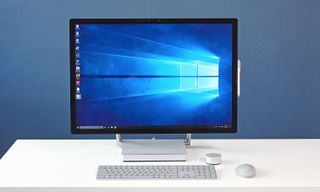
Top-tier all-in-ones, boasting 4K or higher resolution displays, excellent components and the latest ports and features can easily sell for $2,000 or more. These are the cream of the crop, with large displays, Ultra HD resolution and great sound to match. They feature the latest Intel Core i7 processors, powerful graphics cards, plenty of speedy storage and a wide assortment of ports. If you want the whole package, look at systems like the Apple iMac 27-inch with 5k Retina display, or the Microsoft Surface Studio. They’ll cost a you a hefty amount, but they’ll provide top-of-the-line performance and the fullest selection of features.
For $1,000 to $2,000, you can still get a lot of those features, but you’ll need to be choosy, because you won’t get all of them. Pick one or two premium features as a priority, like a 4K display or dual-drive storage, and then hunt for the best features your budget will let you get in addition to that. There are plenty of great all-in-ones in this price range, like the Asus Zen AiO Pro Z240IE and the Dell XPS 27.
If you wanted to get an all-in-one for gaming, be prepared to spend a little extra. Gaming-focused all-in-ones, like the Lenovo IdeaCentre AIO Y910 or the MSI Gaming 27T, feature high-end graphics cards, plenty of storage space and processing power to spare to run the latest AAA games without a stutter or a dropped frame.
Finally, for the cost-sensitive shoppers out there, you can find a pretty great all-in-one for less than $1,000, but you’ll need to keep your expectations realistic. You may not get 4K resolution or giant 32-inch displays, but you can still get better-than-1080p resolution in sizes upward of 24 inches. Processing hardware will include current Intel Core i5 CPUs, but dedicated graphics cards aren’t common, and when they are available you can expect to see Nvidia and AMD GPUs from a year or two ago. Storage options will include either large spinning hard drives or zippy solid-state drives, but not both. Our favorite option in this price range is the Lenovo IdeaCentre 520S.
Credit: Tom's Guide
Sign up to get the BEST of Tom’s Guide direct to your inbox.
Upgrade your life with a daily dose of the biggest tech news, lifestyle hacks and our curated analysis. Be the first to know about cutting-edge gadgets and the hottest deals.
Brian Westover is currently Lead Analyst, PCs and Hardware at PCMag. Until recently, however, he was Senior Editor at Tom's Guide, where he led the site's TV coverage for several years, reviewing scores of sets and writing about everything from 8K to HDR to HDMI 2.1. He also put his computing knowledge to good use by reviewing many PCs and Mac devices, and also led our router and home networking coverage. Prior to joining Tom's Guide, he wrote for TopTenReviews and PCMag.
